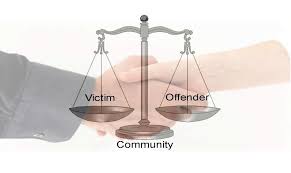Restorative Justice: An alternative to Punitive measures
- ByAdmin --
- 16 Jul 2024 --
- 0 Comments
RESTORATIVE JUSTICE: AN ALTERNATIVE TO PUNITIVE MEASURES
Restorative justice aims to analyze the negative effects of a crime and then identify ways to mend that harm while ensuring the individual responsible is held accountable for their actions. The goal is to both repair the harm and address the underlying causes of the offense, with the intention of minimizing the chances of further wrongdoing. Instead of emphasizing the punishment imposed, the success of restorative justice is evaluated based on how effectively the harm is rectified.
Elements:
1. A key aim of the justice process is to support victims and address their needs, with the victim’s perspective playing a crucial role in deciding how to rectify the harm caused by the crime.
2. Another important goal is to restore the community as much as possible. Offenders bear personal responsibility towards both the victims and the community for the wrongs they have done. All the involved parties in the restorative justice process are accountable for collaborating to repair the harm. The community is responsible for the well-being of all its members, including victims and offenders.
3. Rehabilitation of the offender involves the process of educating those who have committed a crime and preparing them to reintegrate into society. The process involves rectifying every deformity in the criminal, including their behavior, habits, values, thoughts, and addictions. Additionally, it includes addressing their perspectives.
RESTORATIVE JUSTICE PROGRAMMES
1 VICTIM OFFENDER PROGRAMMES Victim-offender mediation programs were some of the first restorative justice initiatives, aimed at meeting the needs of crime victims while ensuring offenders are responsible for their actions. In these programs, crime victims may be directed to receive support and guidance as necessary, and are given significant influence over the punishment or resolution process.
2 COMMUNITY CONFERENCING The process involves gathering the victim's and offender's family and friends, as well as potentially other community members, to engage in a professionally guided discussion aimed at identifying favorable outcomes for all involved, addressing the impact of the crime, and finding ways to prevent similar behavior in the future. The goal of family group conferencing is to make the offender aware of the consequences of their actions, create a plan for making amends, and assess if stricter supervision or custody is necessary.
An alternative to punitive measures
The typical presentation of restorative justice is as an alternative to punishment or a supplement to punishment, rarely as a standalone form of punishment. However, it should be noted that restorative justice is considered an alternative form of punishment by many perspectives on the concept of punishment. Additionally, in comparison to existing alternative punishments such as electronic monitoring and community service, restorative justice stands out for its emphasis on aiding the victims of crimes in their recovery. It is important to recognize that restorative justice has positive impacts, not only in terms of victim well-being, but also in reducing recidivism and economic costs.
The case of Mohd. Firoz vs. State of Madhya Pradesh[1] highlighted the important principle of restorative justice, which aims to give offenders the opportunity to "become socially responsible individuals" after serving their punishment. In this case, the death sentence was commuted to a twenty-year imprisonment for the offence under section 376A, IPC (CRIMINAL APPEAL NO.612 OF 2019).
Conclusion:
The traditional judicial system continues to emphasize that the primary goal of achieving justice lies in the disclosure, validation, and enforcement of punishment, despite the fact that this fails to bring any satisfaction to the victim. India should establish a substantial pool of well-trained restorative justice practitioners capable of serving as proficient mediators. If this is accompanied by a strong state commitment to ensuring law and order for the protection of victims, it could significantly and effectively enhance the legal system as the most efficient and effective alternative for reducing recidivism.
[1] CRIMINAL APPEAL NO.612 OF 2019)

























0 comments